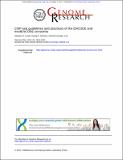| dc.description.abstract | Chromatin immunoprecipitation (ChIP) followed by high-throughput DNA sequencing (ChIP-seq) has become a valuable and widely used approach for mapping the genomic location of transcription-factor binding and histone modifications in living cells. Despite its widespread use, there are considerable differences in how these experiments are conducted, how the results are scored and evaluated for quality, and how the data and metadata are archived for public use. These practices affect the quality and utility of any global ChIP experiment. Through our experience in performing ChIP-seq experiments, the ENCODE and modENCODE consortia have developed a set of working standards and guidelines for ChIP experiments that are updated routinely. The current guidelines address antibody validation, experimental replication, sequencing depth, data and metadata reporting, and data quality assessment. We discuss how ChIP quality, assessed in these ways, affects different uses of ChIP-seq data. All data sets used in the analysis have been deposited for public viewing and downloading at the ENCODE (http://encodeproject.org/ENCODE/) and modENCODE (http://www.modencode.org/) portals. | en_US |
| dspace.orderedauthors | Landt, S. G.; Marinov, G. K.; Kundaje, A.; Kheradpour, P.; Pauli, F.; Batzoglou, S.; Bernstein, B. E.; Bickel, P.; Brown, J. B.; Cayting, P.; Chen, Y.; DeSalvo, G.; Epstein, C.; Fisher-Aylor, K. I.; Euskirchen, G.; Gerstein, M.; Gertz, J.; Hartemink, A. J.; Hoffman, M. M.; Iyer, V. R.; Jung, Y. L.; Karmakar, S.; Kellis, M.; Kharchenko, P. V.; Li, Q.; Liu, T.; Liu, X. S.; Ma, L.; Milosavljevic, A.; Myers, R. M.; Park, P. J.; Pazin, M. J.; Perry, M. D.; Raha, D.; Reddy, T. E.; Rozowsky, J.; Shoresh, N.; Sidow, A.; Slattery, M.; Stamatoyannopoulos, J. A.; Tolstorukov, M. Y.; White, K. P.; Xi, S.; Farnham, P. J.; Lieb, J. D.; Wold, B. J.; Snyder, M. | en |
